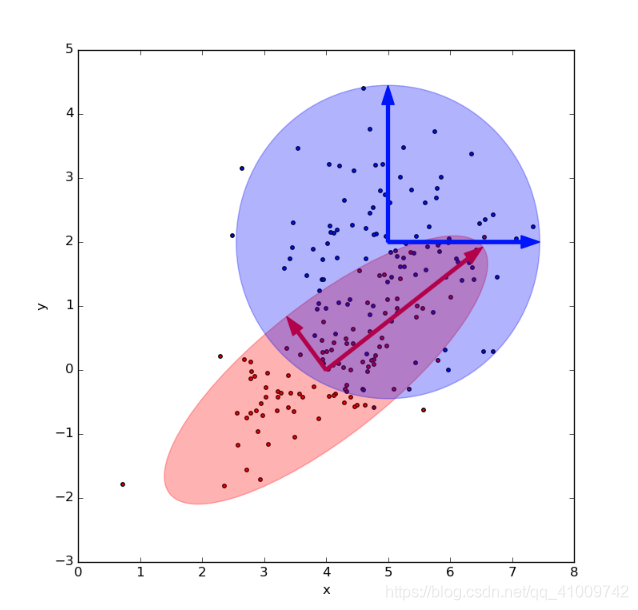为网友们分享了相关的编程文章,网友张安然根据主题投稿了本篇教程内容,涉及到二维正态分布采样、置信椭圆绘制、正态分布采样、二维正态分布采样置信椭圆绘制相关内容,已被943网友关注,下面的电子资料对本篇知识点有更加详尽的解释。
二维正态分布采样置信椭圆绘制
二维正态分布采样后,绘制置信椭圆
假设二维正态分布表示为:

下图为两个二维高斯分布采样后的置信椭圆

和

每个二维高斯分布采样100个数据点,图片为:

代码如下
#!/usr/bin/env python
# -*- coding: utf-8 -*-
import numpy as np
import matplotlib as mpl
import matplotlib.pyplot as plt
def make_ellipses(mean, cov, ax, confidence=5.991, alpha=0.3, color="blue", eigv=False, arrow_color_list=None):
"""
多元正态分布
mean: 均值
cov: 协方差矩阵
ax: 画布的Axes对象
confidence: 置信椭圆置信率 # 置信区间, 95%: 5.991 99%: 9.21 90%: 4.605
alpha: 椭圆透明度
eigv: 是否画特征向量
arrow_color_list: 箭头颜色列表
"""
lambda_, v = np.linalg.eig(cov) # 计算特征值lambda_和特征向量v
# print "lambda: ", lambda_
# print "v: ", v
# print "v[0, 0]: ", v[0, 0]
sqrt_lambda = np.sqrt(np.abs(lambda_)) # 存在负的特征值, 无法开方,取绝对值
s = confidence
width = 2 * np.sqrt(s) * sqrt_lambda[0] # 计算椭圆的两倍长轴
height = 2 * np.sqrt(s) * sqrt_lambda[1] # 计算椭圆的两倍短轴
angle = np.rad2deg(np.arccos(v[0, 0])) # 计算椭圆的旋转角度
ell = mpl.patches.Ellipse(xy=mean, width=width, height=height, angle=angle, color=color) # 绘制椭圆
ax.add_artist(ell)
ell.set_alpha(alpha)
# 是否画出特征向量
if eigv:
# print "type(v): ", type(v)
if arrow_color_list is None:
arrow_color_list = [color for i in range(v.shape[0])]
for i in range(v.shape[0]):
v_i = v[:, i]
scale_variable = np.sqrt(s) * sqrt_lambda[i]
# 绘制箭头
"""
ax.arrow(x, y, dx, dy, # (x, y)为箭头起始坐标,(dx, dy)为偏移量
width, # 箭头尾部线段宽度
length_includes_head, # 长度是否包含箭头
head_width, # 箭头宽度
head_length, # 箭头长度
color, # 箭头颜色
)
"""
ax.arrow(mean[0], mean[1], scale_variable*v_i[0], scale_variable * v_i[1],
width=0.05,
length_includes_head=True,
head_width=0.2,
head_length=0.3,
color=arrow_color_list[i])
# ax.annotate("",
# xy=(mean[0] + lambda_[i] * v_i[0], mean[1] + lambda_[i] * v_i[1]),
# xytext=(mean[0], mean[1]),
# arrowprops=dict(arrowstyle="->", color=arrow_color_list[i]))
# v, w = np.linalg.eigh(cov)
# print "v: ", v
# # angle = np.rad2deg(np.arccos(w))
# u = w[0] / np.linalg.norm(w[0])
# angle = np.arctan2(u[1], u[0])
# angle = 180 * angle / np.pi
# s = 5.991 # 置信区间, 95%: 5.991 99%: 9.21 90%: 4.605
# v = 2.0 * np.sqrt(s) * np.sqrt(v)
# ell = mpl.patches.Ellipse(xy=mean, width=v[0], height=v[1], angle=180 + angle, color="red")
# ell.set_clip_box(ax.bbox)
# ell.set_alpha(0.5)
# ax.add_artist(ell)
def plot_2D_gaussian_sampling(mean, cov, ax, data_num=100, confidence=5.991, color="blue", alpha=0.3, eigv=False):
"""
mean: 均值
cov: 协方差矩阵
ax: Axes对象
confidence: 置信椭圆的置信率
data_num: 散点采样数量
color: 颜色
alpha: 透明度
eigv: 是否画特征向量的箭头
"""
if isinstance(mean, list) and len(mean) > 2:
print "多元正态分布,多于2维"
mean = mean[:2]
cov_temp = []
for i in range(2):
cov_temp.append(cov[i][:2])
cov = cov_temp
elif isinstance(mean, np.ndarray) and mean.shape[0] > 2:
mean = mean[:2]
cov = cov[:2, :2]
data = np.random.multivariate_normal(mean, cov, 100)
x, y = data.T
plt.scatter(x, y, s=10, c=color)
make_ellipses(mean, cov, ax, confidence=confidence, color=color, alpha=alpha, eigv=eigv)
def main():
# plt.figure("Multivariable Gaussian Distribution")
plt.rcParams["figure.figsize"] = (8.0, 8.0)
fig, ax = plt.subplots()
ax.set_xlabel("x")
ax.set_ylabel("y")
print "ax:", ax
mean = [4, 0]
cov = [[1, 0.9],
[0.9, 0.5]]
plot_2D_gaussian_sampling(mean=mean, cov=cov, ax=ax, eigv=True, color="r")
mean1 = [5, 2]
cov1 = [[1, 0],
[0, 1]]
plot_2D_gaussian_sampling(mean=mean1, cov=cov1, ax=ax, eigv=True)
plt.savefig("./get_pickle_data/pic/gaussian_covariance_matrix.png")
plt.show()
if __name__ == "__main__":
main()
总结
以上为个人经验,希望能给大家一个参考,也希望大家多多支持码农之家。









